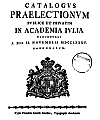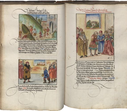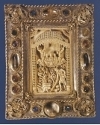
Projects
When you think of libraries you think of books - but you might be surprised: beside maps, single sheet woodcuts, town views, portraits and further graphic reproductions also drawings, architecture plans and sketches enrich the holdings of Wuerzburg University Library. Discover the full graphic collection in our new image database Pictothek and find further image material such as manuscript illuminations, initials, book illustrations, decorative front pages and bindings!
Journey of Pfalzgraf Ottheinrich 1536/77
It is 1536 – Ottheinrich of Pfalz-Neuburg is 34 years old, quite fat and highly in debt. To avoid the threatening bankruptcy, he remembers a borrower‘s note in his possession - the dowry of his polish grandmother called Hedwig. It had never been actually paid off since the famous „Landshuter Hochzeit“ with Georg dem Reichen in 1475. In the autumn of the year 1536 Ottheinrich travels to Krakau and receives in fact the outstanding money - 32.000 gulden. His journey is accompanied by an artist, painting all the 50 resting places and capturing them in water colour.
Würzburger Vorlesungsverzeichnisse 1785-1945
The University of Würzburg was founded - after a predecessor institution at the beginning of the 15th century was very short lived - in 1582 by Prince Bishop Julius Echter. There were no printed course catalogs in our present sense in the first two centuries. From 1785 course catalogs were regularly published. Course catalogs are, of course, primarily intended to announce lectures, but also to provide information about the staff involved, the structure of the university, its institutes and far more information. In the Würzburg lecture catalogs, staff directories and/or student directories were included, and from 1830/31 these were published separately. To search for course catalogs in a library catalogs is difficult, because of their numerous title variations. The digitization project consequently refers to them as "lecture catalogs". The digitization of the directories of staff and students will follow in an envisaged second part of the project. For reasons of personal and copyright law, the digitization ends in 1945 for the time being.
Georg Spalatin (1484-1545) particularly reknown as adviser and intimate of Martin Luther was actually a member of the court of Friedrich III of Sachsen, called Friedrich der Weise. In 1510 he began to write a chronicle about the history of Saxonians, Thuringians and the citizens of Meißen, from their beginnings up to the present time. Spalatin never managed to finish his work – the 4 existing pieces nevertheless are more than impressive: 3 big manuscripts, illuminated by the famous workshop of Cranach are today located in the Landesbibliothek Coburg, a fourth part is among the holdings of the Thüringische Hauptstaatsarchiv in Weimar. For the very first time the 4 parts are virtually united on Spalatin Online.
Pomona, the Roman goddess of fruitful abundance, gave her name to the three-volume work "Pomona Franconica", which deals with fruits and fruit tree breeding. The Würzburg court gardener Johann Prokop Mayer (1735-1804) published it in the years 1776 to 1801. To him, the pomological literature of the time seemed badly illustrated. To achieve better illustrations, he worked together with the Nuremberg publisher Wolfgang Adam Winterschmidt, the outstanding botanical book illustrator of his time.
The newspaper was founded as a Rhön- and Saalpost in 1862 by Max Josef Mayer, who came from Regensburg. This led the newspaper in a liberal spirit, as the Neustädter Time war in 1869 with the newspaper: The Bavarian Fatherland. In the context of the elections taking place in the Kingdom of Bavaria, publishers and the newspaper took up the position of progressive forces, defending the Jewish fellow-citizens.
In 1893, Mayer's stepson Gallus Rötter took over the management of the publishing house after the death of the newspaper founder. It appeared throughout, except for the years 1945-1949. The majority of the other Lower Franconian newspapers had long since ceased to exist.
Until 2008 the newspaper remained family-owned. Then the newspaper was sold to a Berlin finance company. The commercial printing shop was founded in 2011 as an independent company Rötter-Print. In 2012 the 150th anniversary of the newspaper was celebrated.
The manuscripts of the former Würzburg Cathedral library – or the “libri Sancti Kyliani” as the ownership entry on the flyleaf reads – rank among the most prestigious collections of Würzburg University Library today. Once the carefully guarded private propriety of the Franconian apostle St. Kilian, these codices which bear testimony to Würzburg’s cultural history since the foundation of its bishopric in 742 are now to become accessible for everyone: A project promoted by the Deutsche Forschungsgemeinschaft and the Bayerische Staatsministerium für Wissenschaft, Forschung und Kunst is about to digitise the complete collection of the Cathedral Library manuscripts preserved in Würzburg and to make them accessible via an innovative web portal.










